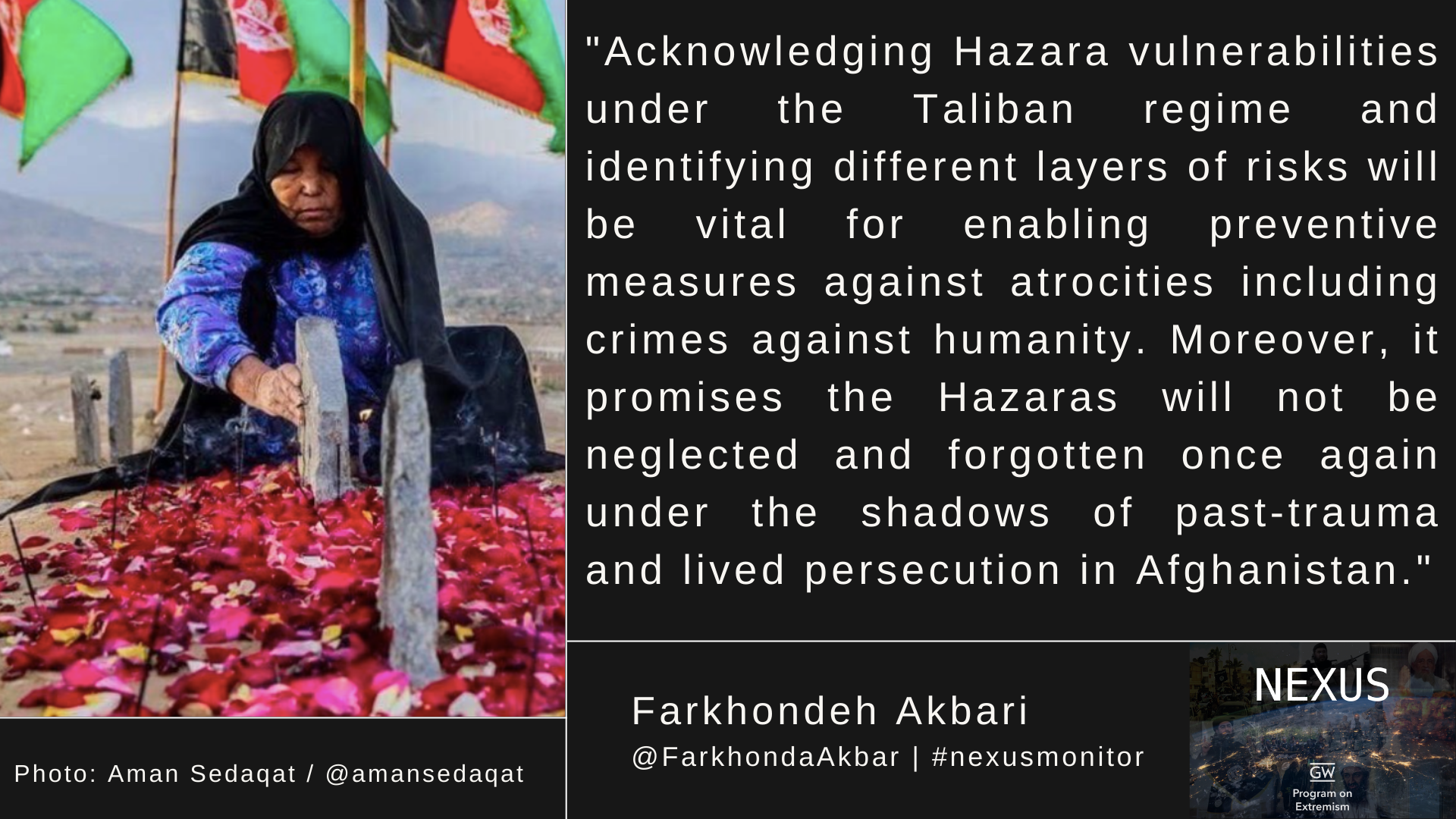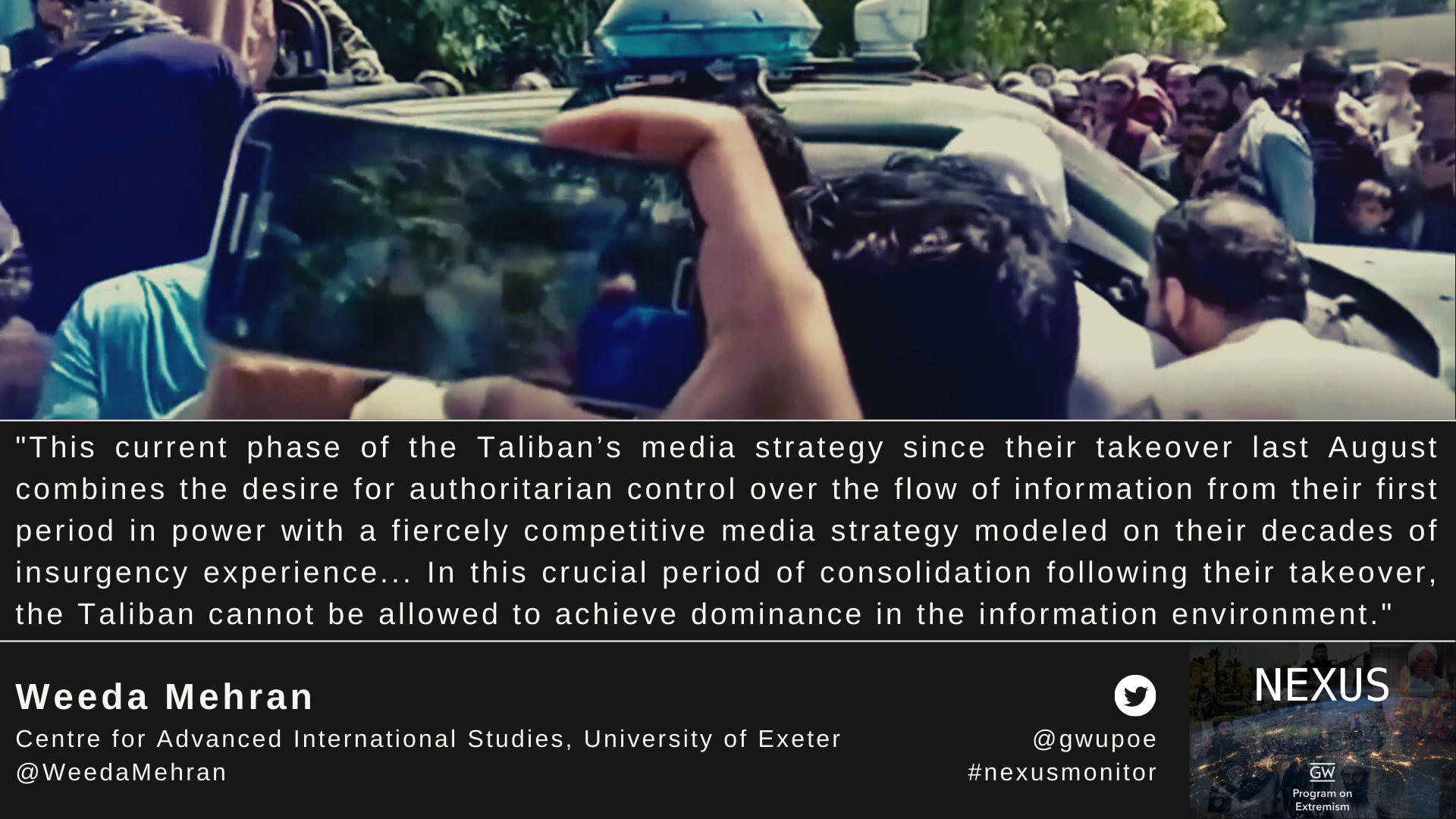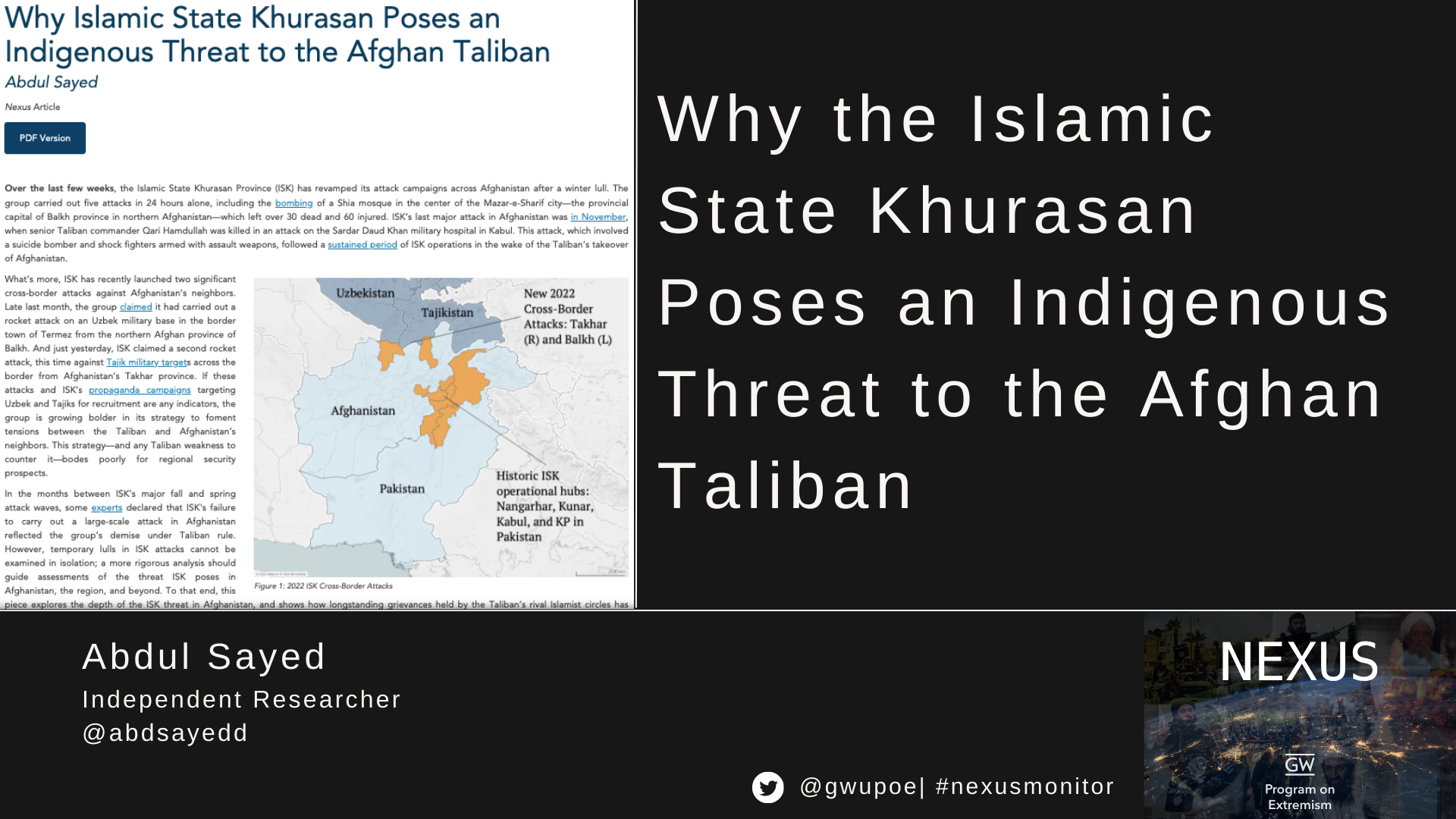PDF Version
IN A MERE SEVEN MONTHS since their return to power in Afghanistan, the Taliban have embarked on a radical and swift reversal of the political, social, and civil gains of the last two decades, increasing the vulnerability of the ethnic Hazaras in the country. Discriminatory practices, extortion, extrajudicial killings, and forced displacement have all resumed. Hazaras are likely to continue to suffer under the new de facto rulers, with their political and civic rights further restricted under an extremist Sunni interpretation of Islam and ethnic prejudice that characterizes the Taliban regime.
This article places the Taliban’s return to power in context, and identifies some of the key issues facing the Hazara community today, including political participation, security, and women’s roles in Afghan society. It concludes with three potential scenarios confronting Hazaras living in Taliban-ruled Afghanistan.
The Taliban’s Return to Power
The Hazaras are one of the main ethnic and religious minority groups in Afghanistan, constituting around 20 percent of the population. The Hazaras have long been subjugated and subjected to discrimination and persecution due to their ethnic and religious identity. The first Taliban rule in the 1990s was devastating for Hazaras— thousands were persecuted and massacred. Over the span of a few days in August 1998 alone, the Taliban killed over 2000 Hazaras in an event that journalist Ahmad Rashid described as “genocidal in its ferocity”. Furthermore, the UN discovered mass graves of Hazaras in Bamiyan just a month before the fall of the Taliban regime in 2001. These experiences had a long-lasting, traumatising effect on the collective memory and consciousness of the community.
The last two decades of foreign intervention and experiments with a republican form of government were considered an era of opportunity for the Hazara community, one in which Hazaras were recognized, at least formally, as equal citizens under the 2004 constitution. After a long history of persecution and discrimination, the presence of the international community in Afghanistan and their promise to support liberal democracy inspired Hazaras to believe that this was a genuine opportunity for a better future. Although the community was represented by prominent Hazara politicians, but they did not necessarily give voice to the main concerns of ordinary Hazaras. The community felt the continuation of systematic discrimination and lack of meaningful political participation. It was only in the grassroots that the Hazaras played a central role in democratization and institution-building processes, including by becoming major voices for liberal and democratic values within the media and civil society sectors. Voter turnout in Hazara districts and provinces was consistently high. Hazara women had an active and visible presence in public spaces and spearheaded meaningful contributions to women-led initiatives.
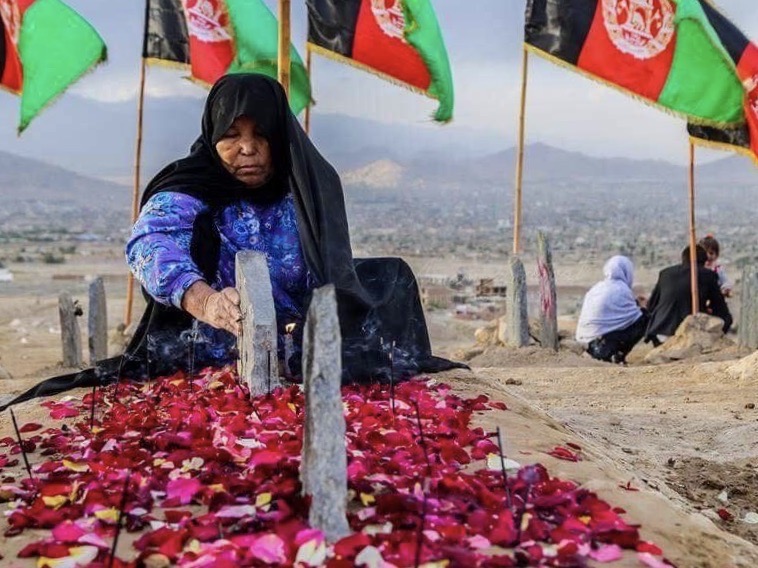
A Hazara mother at the grave of her child, killed at a Hazara social movement protesting for equal distribution of power in Afghanistan. Photo: Aman Sedaqat / @amansedaqat
Subsequently, because of their support for democracy in Afghanistan, Hazaras were regularly targeted by the Taliban insurgency. Taliban perceptions that Hazaras had stepped out of their historical role as a subordinate and inferior group led the violent extremists to push back in an increasingly targeted and violent manner. Now, with the Taliban back in power, Hazaras face direct threats and systematic discrimination in Afghanistan. With nearly complete collapse of independent media and civil society, the Hazara diaspora have also lost their “eyes and ears” to report on the community’s vulnerable situation and advocate for their plight. Hazara advocates for human rights have relied on civil society efforts inside the country, and with the Taliban in power the community’s agency has been lost. Addressing access issues to monitor the plight of Hazaras under the Taliban rule will be critical for identifying and preventing crimes against the community.
Political Participation
In the Taliban’s totalitarian Islamic Emirate of Afghanistan, there is no meaningful political inclusivity or representation for Hazaras at any level. Since regaining control of Afghanistan last year, the Taliban have implemented overtly discriminatory policies. While parts of the international community have voiced concerns about the plight of Hazaras, the Taliban have rejected the international community’s call for inclusivity by arguing that people who worked for the governments of the last twenty years will not be accepted. In their understanding, inclusivity is limited to Sunni religious groups, as well as factions and fronts that fought under the banner of the Taliban and attended religious schools in Pakistan and certain parts of Afghanistan.
When the Taliban announced their caretaker government in September 2021, it was revealed that several members of the Taliban’s Haqqani network, the faction considered closest to Pakistan and led by designated global terrorists, were appointed to key positions in the cabinet. Hazaras are represented neither in the Taliban interim cabinet (33 members), nor as provincial and district governors (34 provinces, 387 districts), mayors, or police chiefs. In the three largely Hazara-populated provinces of Bamiyan, Daikundi, and Ghazni, Hazaras do not occupy any senior government position. For example, in Bamiyan, the new governor, Mullah Abdullah Sarhadi, is an extremist from Zabul province with links to the Taliban’s Quetta Shura, who were involved in the massacres of Hazaras in Bamiyan and the destruction of the Buddhas of Bamiyan.
Overall, the cabinet’s makeup and policies show that it is serving the Taliban movement rather than an ethnically and culturally diverse population of 38 million people. The Taliban are occupied with maintaining the movement’s internal cohesion and demonstrate little concern for the average Afghan, let alone despised minorities like the Hazaras. The exclusion of Hazaras at all levels is largely due to their history of opposition to the Taliban. Consequently, the Taliban have often appeared to be driven by revenge against Hazaras. George Packer in an article quoted a Hazara woman who stated that “Talibs had told the imam of the Shiite mosque in her family’s Kabul neighborhood that they would kill any local Hazara soldiers they might later find if he didn’t give up their names now.”
Facing international pressure for political inclusivity as a condition for recognition, the new Taliban regime appointed two Hazara men to mostly symbolic positions. The first is the appointment of a 33-year-old criminal-turned-commander known as Mawlawi Mahdi. He joined the Taliban in recent years as a low-level commander in Sari-Pul province before rising to the position of intelligence chief for Bamiyan province for a few months until he was recently dismissed and shifted to another role in Kabul. Reportedly, Mawlawi Mahdi’s dismissal from Bamiyan is also believed to be influenced by the perception, according to an analyst interviewed from Bamiyan province, that “Mehdi can be biased towards his ethnic group and not share critical intelligence information the Taliban may face from the Hazaras.” The second is Abdul Latif Nazari, who was appointed as Deputy Minister of Economy.
The symbolic appointments of Hazaras mentioned above do not promise any genuine representation, security, or protection for the Hazara community in the Taliban’s Afghanistan. Ethnic Hazaras are also being dismissed from the government’s bureaucracy under the pretext of reform to make an “Islamic” system designed by and for the Taliban. A lecturer from Bamiyan University, whose name is withheld for security reasons, emphasized that Hazaras are “removed from all layers of civil services in Bamiyan under the pretext of reform and reshuffling.” According to the lecturer, eight people were recently dismissed from the education department without reason. Similarly, in a recent move the Taliban have reshuffled the judiciary and cleansed Hazaras from all layers of Afghanistan’s judicial bodies—including removing 100 judges—stating that the “Hazaras cannot be a judge.”
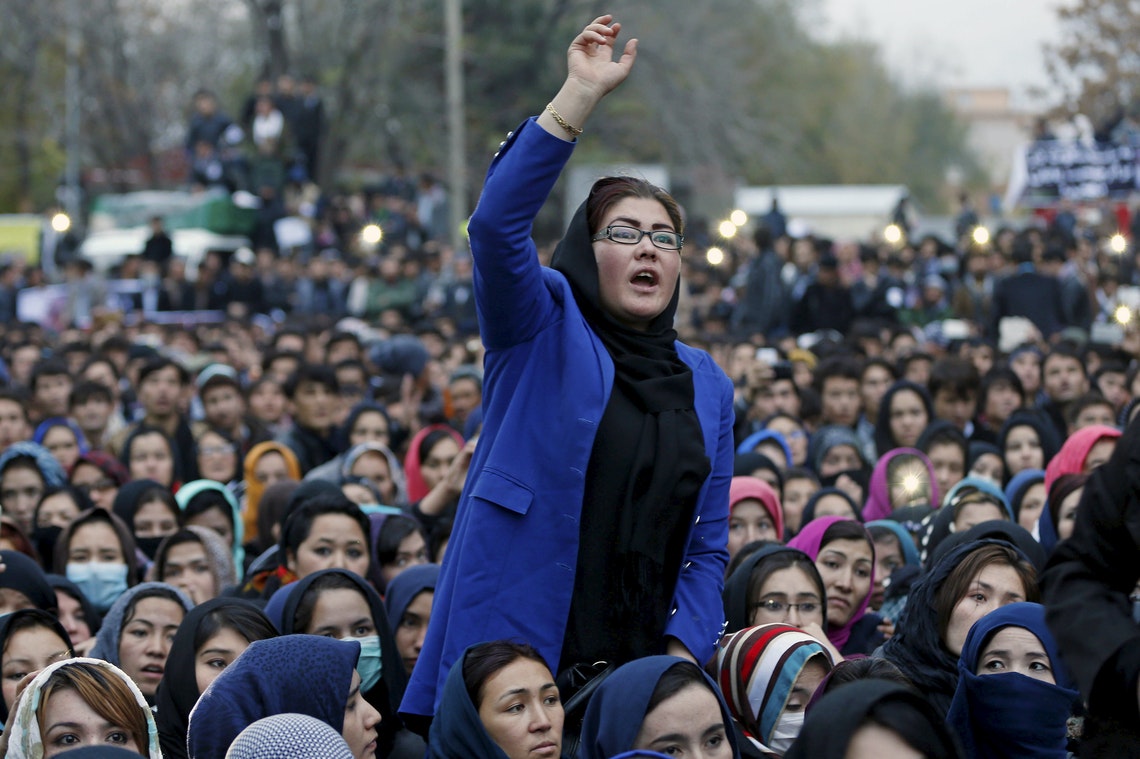
Women gather in Kabul in November 2015 to protest the killing of Hazaras. Photo: Omar Sobhani/Nescom.
Security Threats
Hazaras have been the targets of systematic violent attacks for decades in Afghanistan. There are emerging concerns that the community is at risk of being the targets of crimes against humanity and even genocide. The Australian National University's Atrocity Forecasting ranks Afghanistan in its top five list of countries at risk of genocide onset or politicide. Since the Taliban takeover, targeted attacks against Hazaras have continued, although most attacks have been claimed by ISIS-K. At least half a dozen attacks have occurred in Dasht-e-Barchi alone. Mass casualty attacks on Shiite and Hazara houses of worship occurred in Kunduz and Kandahar, killing more than 90 people and injuring hundreds.
Attacks against the Hazaras have gradually increased in parallel with instability over the last decade. In 2011, suicide bombers attacked Shiite gatherings commemorating the day of Ashura, killing 59 people in Kabul and four in Mazar-e-Sharif. In November 2015, seven Hazara travellers were slaughtered in Zabul province, including two women and a 9-year-old girl, Tabassum. The tragic incident triggered a large demonstration in Kabul demanding protection of Hazaras from the government. In October 2018, the Taliban attacked Hazaras in the Jaghori and Malistan districts of Ghazni province and in Khas Uruzgan, seemingly to prove the government's inability to protect Hazaras.
Attacks against Hazaras continued to escalate last year, and in the first six months of 2021 UNAMA recorded 20 deliberate attacks against the Hazara ethnic group that resulted in around 500 civilian casualties. In Kabul alone, the Hazara neighbourhood of Dasht-e-Barchi has witnessed a bloodbath of young Hazaras, with attacks targeting schools, maternity clinics, sports centres, as well as social and political gatherings. The attacks on the young generation of Hazaras flagged the community's concern about their survival and future in the country. However, the previous government failed to protect the community, something made worse by a refusal to recognise that attacks against Hazaras are almost always motivated by identity. Perpetrators have not been brought to justice, especially those involved in attacks claimed by ISIS-K.
In addition to continued attacks, Hazaras now face additional insecurities under the new Taliban regime including land grabbing and forced displacement from their ancestral lands. It is reported a large number of Hazara families from Daikundi, Balkh, Helmand, Kandahar and Urozgan provinces were forcibly displaced and their homes and farms were confiscated. Villagers have claimed that the Taliban have given them notice to leave their homes within days and their lands were rewarded to Taliban loyalists.
Amidst the world’s worst humanitarian crisis in Afghanistan, discrimination and security threats deprive Hazaras of access to humanitarian aid and international support. A recent example shows that twenty private schools from district 13 of western parts of Kabul—home to Hazara populations—were eligible to receive student fees from the Asia Foundation, but Hazara schools were deselected by the authorities and the support diverted. There are many other accounts from locals that reveal the Taliban’s discrimination against the Hazaras in accessing humanitarian aid, and which are not reported by international media outlets. The community is under immense pressure for survival with no meaningful support.
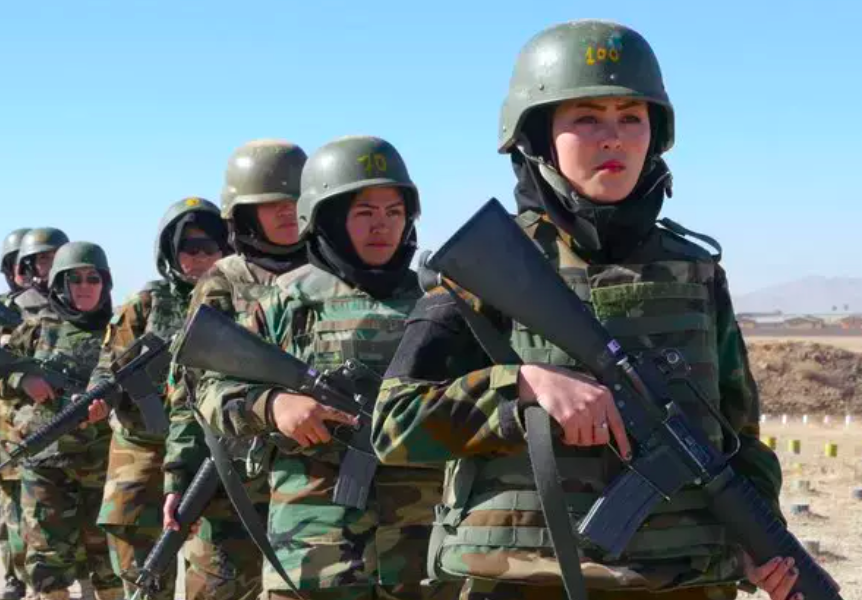
Hazara women in Afghan National Army military training, Herat province. Photo: Omar/Salaam Times
Hazara Women
Within the Hazara community, the most vulnerable group is women. Historically, Hazara women have enjoyed greater freedom because of the community’s relatively open position on girls’ education, women’s employment, and participation in political and social spheres. What’s more, Hazara women served in the ANDSF, were leading voices in Afghanistan’s civil society and media, and have been at the forefront of breaking taboos and barriers in Afghanistan.
Hazara women and girls were hikers, skiers, cyclers, and performers in arts festivals. Their presence was visible in public sectors. Under the new de facto regime, women have lost all the gains of the last two decades in civic and political spaces. As a leading Hazara woman figure in civil society interviewed for this article said, “our struggle for women’s rights was like playing in a boxing ring with changing rules. In the Taliban’s regime, it is no longer about rules. The ring is absent entirely.”
Few Hazara women from Afghanistan’s civil society and security sectors were able to evacuate the country in August 2021. Women and girls who mostly worked in grassroots community organizations did not have the privilege of being placed on evacuation lists and had no connections to foreign embassies. The evacuation process was monopolized by networks of power, none of which helped the Hazaras. Hazara women and girls, who are facing genuine threats against their work in the security and civil society sectors, continue to be exposed to threats, and many are underground or leaving for neighbouring countries with no prospects of formal resettlement. Nazia, a Hazara woman from Daikundi working in Bamiyan who was interviewed for this article, said she is trying to sell her house and vehicle, and resigned from her job to seek refuge in Pakistan. When asked about her decision, she sombrely said that, “I worked for a human rights NGO, and I am a Hazara woman. I have no chance of survival if the fire erupts”— referring to the risk of another Hazara massacre in Bamiyan. Such fears of persecution are lingering among Hazaras in all parts of Afghanistan who still carry the trauma from the Taliban regime of the 1990s.
Furthermore, disappearances and the abduction of activist women is becoming common under the Taliban regime. Alia Azizi, a Hazara woman who heads Herat Women’s Prison, was abducted four months ago and her whereabouts remains unknown. These examples reveal the threats that Hazara women—among other Afghan women who have worked for progress over the previous 20 years—face under the current Taliban regime. Every day of the last seven months has been a rollback of their hard- earned-gains to overcome Afghanistan’s patriarchal practices and gender-based violence and discriminations.
What’s Next for Hazaras? Three Possible Scenarios
The rise of extremism and the possibility of Afghanistan becoming a haven for regional and international terrorist organisations is particularly alarming for the Hazaras. The Taliban’s current policies and practices are dangerously paving the way to further devastation and catastrophe in the country. The Hazaras will be impacted the most as their vulnerabilities are historic and numerous. There are three possible scenarios that confront Hazaras in Afghanistan living under Taliban rule.
The first scenario is the current status quo remains largely the same. As the Taliban tighten control, it is likely that opportunities for Hazaras shrink even further, given that there are no Hazaras at any meaningful level of the regime. Forced displacement, systematic discrimination, and targeted attacks against the community will continue. Extortion of Hazaras by Taliban leadership and rank-and-file will persist. Ismael, a Hazara businessman interviewed for this article, shared that he was asked to pay a 1000 USD bribe to a Taliban officer to register his car that should have only cost approximately 150 USD. When asked why he was charged such a large sum, the Talib officer replied that, “a Hazara should be thankful that a Talib is processing his vehicle’s registration at the cost of dollars and not killing him.” There are many similar examples of community members facing corruption and extortion in their encounters with Taliban fighters. Under this scenario, the Hazaras may not be the target of deliberate violence such as massacres, but will gradually be subjected to political and socio-economic repression that pushes them to the extreme margins of society.
A second scenario is civil war and escalation of the risk of genocidal violence against the Hazaras if the Taliban fail to transition to a national system of government and consolidate fragmentations of internal factions. In the first seven months of Taliban rule, no meaningful steps were taken to demonstrate a willingness to form an inclusive and national government. Yet the Taliban are, to some extent, hostages of internal cohesion issues and so are occupied with maintaining a fragile internal balance of power to avoid fragmentation. A loss of control over their rank-and-file would have catastrophic consequences for the Hazaras. While the Taliban are often praised for their cohesion during decades of insurgency as a military organization, that cohesiveness in a time of relative peace but also humanitarian crisis may prove difficult to maintain. Despite significant shifts in the Afghan political landscape, the Taliban’s ideology and political agenda proved instrumental in enabling the movement to maintain and sustain itself through violence. Commanders and foot soldiers—some of the Taliban’s most ideologically rigid members driven by propaganda, revenge, and hatred—may increasingly turn their ire towards the Hazaras. In this scenario, the survival of Hazaras may depend on the extent to which locals can make deals with different factions and use internal rivalries to their favour. However, this will likely increase the prospects of a dangerous civil war, which will place Hazaras in an extremely vulnerable position with increased risks of genocidal violence.
A third scenario is an inclusive political process for a legitimate government and a meaningful peace in Afghanistan. This is probably the most unlikely yet best-case scenario for the Hazaras to solve the current crises and a pathway to enduring peace and security for Afghanistan. The international community still has leverage over the Taliban based on political recognition, humanitarian aid, economic prospects, and regional connectivity that could drive an inclusive political process. However, previous encounters with the Taliban have shown their lack of willingness and propensity for political and diplomatic engagement for a meaningful outcome, and thus makes this scenario the least likely. The Taliban’s main vision was a military takeover and a victory claim; this is already achieved, and its consequences have proved catastrophic for Afghanistan. Only if the Taliban leadership realise that their endurance in Afghanistan will be dependent on national and international political legitimacy can they begin internal organisational evolution to prepare for political inclusivity.
Conclusion
Hazaras faced massacres, persecution, destruction of their cultural heritage, and the erasure of their identity during the first Taliban rule in the 1990s. Even in post-2001 Afghanistan, Hazaras were persecuted and violently targeted for their ethnic and religious identities as well as their roles in the national government and civil society. But at least during that period, Hazaras mobilised around their shared causes of equality, democracy, human rights, and equal access to education—a belief in a brighter future—to inspire them. Under the Taliban, the moment for collective mobilisation has dissipated, and many hard-fought gains have been wasted. Those achievements have amounted to nothing except increasing risks to lives and livelihoods.
In any scenario, the role of the UN Special Rapporteur on Human Rights in Afghanistan (yet to be appointed) will be critical to advocate for the Hazara community’s protection and to extend appropriate recognition of the risks facing Hazaras. Acknowledging Hazara vulnerabilities under the Taliban regime and identifying different layers of risks will be vital for enabling preventive measures against atrocities including crimes against humanity. Moreover, it promises the Hazaras will not be neglected and forgotten once again under the shadows of past-trauma and lived persecution in Afghanistan.


